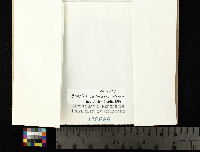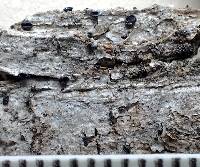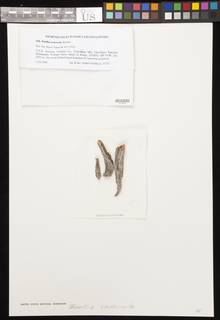
Consortium of Lichen Herbaria
- building a Global Consortium of Bryophytes and Lichens as keystones of cryptobiotic communities -
- Home
- Search
- Images
- Species Checklists
- US States: O-Z >
- US National Parks
- Central America
- South America
- US National Parks
- Southern Subpolar Region
|
|
|
|
Family: Caliciaceae
|
Nash, T.H., Ryan, B.D., Gries, C., Bungartz, F., (eds.) 2007. Lichen Flora of the Greater Sonoran Desert Region. Vol 3. Thallus: crustose, continuous to rimose-areolate, flat to slightly verrucose; prothallus: black surface: pale yellow, smooth, esorediate medulla: white, lacking calcium oxalate (H2SO4-) Apothecia: lecideine, immersed to sessile, abundant, often crowded, 0.2-1.2 mm in diam. disc: black, epruinose, flat to convex margin: black, initially distinct and often covered by thalline residue, later excluded proper exciple: 55-75 µm thick; lacking secondary metabolites; differentiated into a broad, dark brown outer part with carbonized cells (HNO3-), and a pale brown central part, transient with the brown, <120 µm thick hypothecium (HNO3-) epihymenium: brown, pigmentation continuous with the outer exciple (HNO3-) hymenium: hyaline, not inspersed with oil droplets, 75-100 µm tall; tips of paraphyses: ±6 µm wide with distinct apical caps asci: clavate, Biatora-type, 60-72 x 20-32 µm, 8-spored ascospores: soon brown, submuriform to muriform, with <15 cells in optical section, ellipsoid, often slightly curved, (17-)18.3-[21.4]-24.5(-31.5) x (8-)8.9-[9.8]-10.7(-11.5) µm (n=150), walls and septa lacking uneven thickenings, proper wall c. 0.5 µm thick, lacking a perispore, ornamentation: smooth Pycnidia: rare, immersed, with uppermost part protruding, wall mainly pigmented in upper part conidia: bacilliform, 4-5 x c. 1 µm Spot tests: thallus and medulla K+ yellow turning red (crystals), C-, P+ yellow-orange fluorescence: UV- iodine reaction: medulla not amyloid Secondary metabolites: norstictic acid (major), usnic acid (minor), connorstictic acid (trace), and methylpseudonorstictictate (trace). Substrate and ecology: on wood of coniferous trees (e. g. Juniperus spp. and Pinus spp.) in montane forests World distribution: southwestern Europe, northwestern Africa, Arizona, and Texas Sonoran distribution: montane regions of central and eastern Arizona. Notes: Buellia cedricola is characterized by its yellowish tinged thallus, the low profile of its apothecia, and its submuriform to muriform spores. In the field, the species might be confused with Buellia triphragmioides on the basis of its yellowish thallus, but that species differs in its secondary chemistry (thallus K-, C+ orange in B. triphragmioides) and spore morphology (spores 3-septate and with a perispore in B. triphragmioides). |
Powered by Symbiota
















